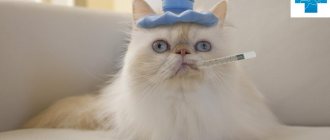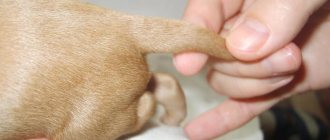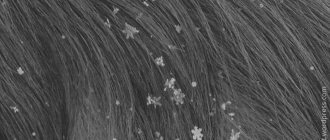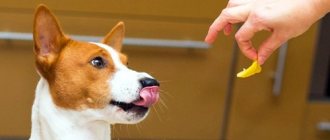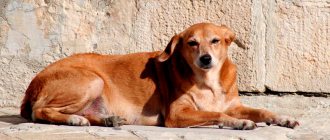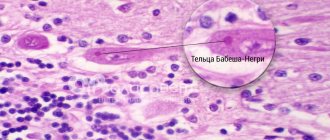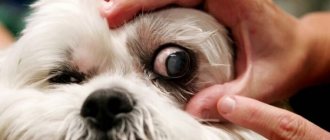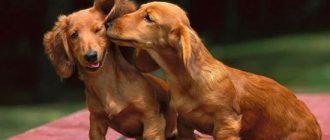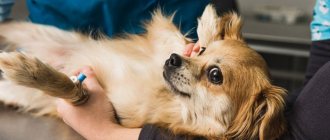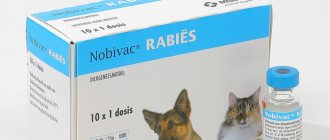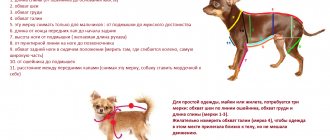Dogs can be injured in various ways: scratched by protruding branches, plant thorns, dry grass, cut by glass or other sharp objects, and damaged paws when jumping. Dogs often fight among themselves, they can be severely scratched and even bitten by cats. Fold-eared breeds with large, “fleshy” ears especially suffer in fights. Another cause of injury is an accident when a dog is run over or hit by a car.
In case of severe injuries, if the bleeding does not stop, or there are large surface defects that require suturing of the skin, it is necessary to quickly take the animal to the veterinarian, otherwise the consequences can be very sad.
If the right decision is not made in time and treatment is not started, the wound may become inflamed and fester. Coping with such a situation will be much more difficult, and the injury may be complicated by blood poisoning.
general information
For mechanical damage to the skin in dogs, complex therapeutic ointments are used. More often they contain 2 or more components. Depending on the composition, they eliminate factors that slow down skin restoration and provide several therapeutic effects:
- Disinfectant – protect the wound from infection.
- Antibacterial - destroy harmful bacteria when suppuration begins in the wound.
- Anti-inflammatory – soften the symptoms of inflammation.
- Pain reliever – reduces pain.
- Regenerating – stimulate the formation of new cells to replace damaged ones.
Each drug has its own method of use, it is described in the instructions. But there are general processing rules:
- Before applying the treatment, the wound is thoroughly washed with soapy water to remove dirt, blood, necrotic particles, and pus.
- Be sure to treat with an antiseptic, for example, Chlorhexidine, Miramistin, Argumistin.
- The hair around the damaged area is cut to 1–2 cm.
- On superficial wounds, abrasions, and scratches, the ointment is applied in a thin layer without a bandage. If the dog licks the treated area, wear an Elizabethan collar until it heals.
- Bandages are applied to open wounds and deep injuries. To do this, a gauze swab is impregnated with a medicinal agent and fixed with a bandage. The dressings are changed 1-2 times a day.
- Fresh, uninfected lesions are treated from the center to the periphery. Purulent, inflamed - from the edge to the center, covering 1 cm of healthy skin.
If the wound does not heal for a long time, pus appears on the surface, the edges become hot, and veterinary attention is needed. It is possible that hygiene was compromised during processing and the dog will need a course of antibiotics.
How to treat deep and festering wounds
Often, saving a dog with a large wound on the head or body depends on the speed of contacting a veterinarian. The wound surface is covered with sterile material and the animal is transported to the clinic. The doctor must be informed how the cut was treated and what means the dog was treated with.
If the situation is not so critical, for example, the dog has severely injured its paw with sharp grass, and a fairly deep cut has festered, you need to follow certain rules. Festering wounds are not sutured, even if the pet owner has such skill. First you need to clean the wound. To do this, dried crusts are soaked in peroxide, removed with sterile gauze, the wound is opened and the pus is removed. Then an ointment or other preparation with healing properties is applied to the entire surface. In order for the wound to heal, a sterile bandage is applied to it, and a special “collar” is put on the pet’s head, which will not allow it to tear off the bandages and lick the damaged areas.
Cuts and scratches on the ears after cleaning using these methods do not need to be lubricated with ointment, but sprinkled with streptocide; they will quickly dry out and become crusty.
IMPORTANT: If dangerous symptoms of rising temperature, convulsions, lethargy, or loss of appetite appear, the dog should be taken to the veterinarian. Most likely, he will recommend specific antibiotics and other medications that are selected individually.
In case of any serious injury, a quick trip to the veterinarian can save the life of the entire family pet, so in difficult cases, do not take risks and seek help immediately.
Levomekol
Antibacterial wound-healing ointment, available for both humans and animals, marked “vet”.
Medical and veterinary Levomekol are identical in composition and contain 2 active ingredients:
- Levomycytin - destroys pathogenic bacteria that cause skin infections.
- Methyluracil - improves cellular metabolism, accelerates healing, stimulates tissue regeneration, strengthens local immunity.
Levomekol is used to treat infected, purulent wounds. Treatments are repeated 1 – 2 times a day. The maximum treatment period is 10 days.
The healing components quickly penetrate the tissues, do not damage healthy cells, and retain their properties even in the presence of pus and blood. The price of a 100 g tube of Levomekol is about 100 rubles.
What to do if the wound does not heal?
To determine your further actions, you should understand the reasons for the process. Long healing times are common in older dogs, recently mothered and nursing bitches, immunocompromised animals, and dogs that scratch or lick a wound.
To speed up healing you need:
- increase the number of wound treatments;
- use wound healing agents;
- limit the animal's access to the wound (use a protective collar or blanket);
- Limit your dog's activity.
Superficial injuries usually heal without complications within 1-2 weeks. If the situation does not change within a month, contact your veterinarian.
Methyluracil
Medical ointment that stimulates cellular regeneration in wounds. It does not contain antibiotics or antiseptics, so it is used for non-infectious injuries.
It contains only the healing component methyluracil, as well as softening and protective lanolin and petroleum jelly. The drug is prescribed for the treatment of poorly healing wounds, cracks, burns, dermatitis, not complicated by infection.
Treatments are carried out twice a day until complete healing. Methyluracil can be combined with antiseptic and antibacterial applications. The price starts from 65 rubles.
Purulent wounds
If the wound occurred after surgery and after primary surgical treatment, it is considered clean.
But after injury with sharp, relatively clean objects over a short period of time, the wounds are usually considered infected. When the degree of bacterial contamination is high and a pronounced inflammatory process is observed, the wound begins to fester. Causes of purulent wounds:
- insufficient hygiene when dressing,
- lack of seam care,
- low dog immunity,
- unhealthy diet
- vitamin deficiency.
Symptoms and signs that indicate a purulent process:
- there is swelling around the wound,
- tissues near the wound become hot,
- the dog whines in pain when touched,
- the temperature rises,
- appetite decreases,
- general condition is depressed.
Closed wounds with deep damage and a narrow entrance hole are especially susceptible to suppuration. Because of this, air does not enter the wound, and suitable conditions are created for the proliferation of pathogens.
Ranosan
Combined ointment for animals developed by Apicenna. The drug contains 4 components that have a complex therapeutic effect:
- Dioxidin is antimicrobial.
- Chloramphenicol (chloramphenicol) – antibacterial.
- Methyluracil is a wound healing agent.
- Lidocaine is an anesthetic.
Apply the ointment evenly with a spatula or gauze pad once a day. Treatment period is up to 14 days.
According to reviews from owners, Ranosan quickly heals open wounds, postoperative sutures, copes with purulent, long-term non-healing injuries, and inflammatory skin lesions. Well tolerated by dogs and does not cause side effects.
Ranosan is available in veterinary pharmacies in powder form. The price of the drug is from 130 rubles.
When to see a veterinarian
- If the dog is bitten by another animal, there is no way to do without a veterinarian. The animal that caused the injury may be sick or rabid, and this threatens not only the death of the pet, but also infection of family members and other innocent people with a fatal disease.
- Urgent assistance from a veterinarian is necessary if the animal is severely injured, for example, by a fall from a height, hit by a car, has a gunshot or knife wound, beaten, or there is a suspicion of fractures and bruises of internal organs. In such a situation, minutes often count.
- Bleeding from a wound that cannot be stopped also requires veterinary attention.
- Rescue of a dog with an extensive wound on the head can only be organized in a well-equipped clinic, as there may be areas of scalping of the skull, concussion, and damage to the skull. Such injuries need to be accurately diagnosed and treated in a veterinary hospital, as the wounds will need to be sutured, plaster and bandages applied to fractures, and special treatments and strong medications used.
Wounds of the skin and underlying tissues without penetration into cavities and organs can be treated at home.
Cytoderm
Regenerating ointment for animals based on three active ingredients:
- Glycolan. Destroys pathogenic microorganisms, strengthens the protective barrier, stimulates healing.
- D-panthenol. Restores skin integrity, softens, moisturizes.
- Vitamins A, E. Accelerate recovery, prevent scar formation.
Cytoderm helps with any type of skin damage - wounds, abrasions, bruises, burns, frostbite, scratching. Quickly heals cracks on the surface of paw pads, reduces irritation on the paws from reagents, improves the condition of the mammary glands in nursing dogs.
Cytoderm is rubbed into problem areas 2-3 times a day until the tissue is completely restored. Price 370 rub.
First aid
When a dog is injured, certain measures are required on the part of its owner:
- First, treat the wound with a solution of hydrogen peroxide, potassium permanganate, furatsilin or chlorhexidine. If you don’t have these products in your home medicine cabinet, you can use clean running water.
- Shave or trim the hair around the wound.
- Lubricate the area around the wound well with iodine or Monclavit-1 (a modern disinfectant preparation based on iodine).
- Try to stop the bleeding using a homeostatic bandage and tight bandaging.
After these actions, preferably without the slightest delay, even with a seemingly trivial wound, you need to show the animal to a veterinarian. After all, poor-quality treatment or incorrect actions by the owner of a four-legged pet can lead to various complications. And with bleeding, any delay could even cost his life.
Dorogovaya balms
Veterinary ointments containing medicinal complexes ASD-2F and ASD-3F. The abbreviation ASD stands for Dorogov's antiseptic stimulant.
ASD medicinal complexes contain biologically active substances with healing properties:
- antimicrobial;
- anti-inflammatory;
- wound healing;
- regenerating;
- immunomodulatory.
The composition contains additional useful components that have a beneficial effect on damaged skin - olive and castor oil, chamomile extracts, calendula.
Dorogova's balms are produced according to three recipes No. 4, No. 6, No. 10. They are identical in composition, but differ in the concentration of ASD - 4%, 6%, 10%, respectively.
The first two recipes are used for dogs:
- Balm 4% is prescribed for the treatment of superficial wounds not complicated by infection, scratches, scratches.
- Balm 6% is used to treat purulent wounds and dermatitis, abscesses, pyoderma, fistulas, cracks on the paw pads.
The ointment is applied twice a day without a bandage or once a day with a bandage. Treatment is continued until complete healing. The balm should not be used on the mammary glands during lactation. Average price 350 rub.
Treatment of wounds depending on their complexity
There is a natural and medical gradation of wounds by depth, type, and complexity. In any case, the dog owner should know how to treat the dog’s wound in order to get the pet to the veterinary clinic in time without allowing it to bleed to death.
Small and superficial wound
The algorithm is simple:
- wash the wound with furatsilin, rivanol or hydrogen peroxide;
- treat the edges with brilliant green;
- apply a bandage.
If there are no medications at hand, you can clean the wound with drinking water, cover it with a plantain leaf and also bandage it with improvised means.
Deep and extensive laceration, but uncontaminated
In this case it is necessary:
- It is necessary to remove the hair around the injury. To do this, generously lubricate it with alcohol, iodine, vodka or gasoline, without touching the wound itself, as this will cause severe pain to the dog. Then trim the hairs, avoiding them getting into the wound.
- Now you need to apply a tight bandage and take your pet to a veterinary surgeon, since you will not be able to eliminate all the consequences on your own.
Deep and extensive laceration, heavily contaminated
You should:
- Clean the wound by rinsing with hydrogen peroxide, a solution of furatsilin, rivanol or a weak concentration of potassium permanganate. You can use cold boiled water.
- Then treat the edges of the wound with iodine, brilliant green or peroxide. Make a bandage
- You can put a cotton swab soaked in peroxide and wrapped in a bandage under it.
- Take your dog to the vet immediately.
Paw cut
Most often a wound appears on a dog's paw. Fortunately, the list of necessary measures is quite simple.
- wash the wound with a disinfectant solution;
- treat the edges with iodine, peroxide, brilliant green, creolin;
- apply a tight bandage with a cotton swab and bandage tightly again;
- When going for a walk, wear a special shoe or sock.
Penetrating chest injury
This is a very serious injury to your pet. Symptoms include wheezing exhalations and bloody foam protruding from the wound and being sucked back in when inhaling.
You need to react quickly and soberly to prevent the dog from dying from suffocation.
Algorithm:
- quickly treat the edges of the wound with iodine or brilliant green;
- Lubricate the fur around a radius of 5 cm with Vaseline;
- apply a sealed material to the wound - a plastic bag, film, paper, apply cotton wool on top and bandage it;
- as an alternative, you can make a tampon from gauze, cotton wool and bandages, moisten it generously in a disinfectant solution and cover the wound with it, bandage the top with several layers of bandages;
- Deliver your pet to a veterinary hospital within 6-8 hours.
Abdominal injury
Such damage can lead to intestinal prolapse and death. If the intestines do not fall out, proper medical care increases the animal's chances of survival. Find a piece of dense fabric and use it to disinfect the wound - the usual furatsilin is best.
What to do:
- moisten a clean cloth in a solution of furatsilin, rivanol, baking soda and cover the wound with it to prevent the intestines from drying out;
- secure with adhesive tape or medical glue;
- Do not water or feed your pet! Since the organs of the gastrointestinal tract may be damaged or perforated;
- immediately, no later than 4-6 hours, take to the clinic.
It is impossible to control the movements of our four-legged friends, because they are very playful, inquisitive and active. No matter what happens, you must remain sane and calm, act quickly and carefully. You need to remember that time is precious and, after providing first aid, show your furry pet to a specialist. Do not skimp on affection and care, thus contributing to an even faster recovery of the dog.
Pikhtoin
Veterinary ointment based on pine resin (resin), which is famous for its medicinal properties:
- Disinfects wounds.
- Stimulates metabolic processes in cells.
- Accelerates regeneration.
- Promotes healing of damage.
- Stops the inflammatory process.
- Relieves swelling and pain.
The biologically active substances of oleoresin are absorbed through the sebaceous glands and enter the deep layers of the skin, where they improve blood supply, dilate blood vessels, and resolve inflammatory products.
Fir is used to treat wounds, eczema, burns, boils, and dermatitis. For mastitis and bruises, warming bandages are applied. Treatments are carried out 1 – 2 times a day for 5 – 10 days. Before each application, remove any remaining ointment from the previous treatment with a napkin. A 15 g jar of Pikhtoin costs from 50 rubles.
Lacerations
A laceration occurs when the integrity of tissue is damaged by sharp objects. These could be: fangs and claws of other animals, a piece of iron or iron wire, a stone. In this case, sharp objects inflict a wound in an oblique direction, in contrast to a cut wound with smooth edges. The skin with such a wound is torn unevenly and diverges into flaps at the edges.
During the examination, the veterinarian can observe torn ligaments, tendons, muscles, blood vessels, fascia (the connective tissue membrane of muscles, organs, vessels, nerves).
What is the danger?
Such a wound becomes a favorable environment for the development of infections, because dirt accumulates on its edges, and torn edges take a long time to heal. There is a high risk of an inflammatory process.
Lacerated wounds are stitched up in a veterinary clinic, where you should go as quickly as possible - before inflammation begins.
Trauma gel
Complex homeopathic preparation for animals against skin lesions.
Contains matrix tinctures of medicinal herbs, organic and mineral components with a pronounced therapeutic effect:
- anti-inflammatory;
- painkillers;
- regenerating;
- decongestant.
Injury gel is used to treat wounds, cuts, bites, abrasions on the skin, mucous membranes and paw pads, and postoperative sutures. The drug is applied to injured areas in the morning and evening. The duration of treatment for dogs is 5 – 10 days. Depending on the severity of the damage, the course can be extended. A jar of Trauma gel 20 ml costs from 180 rubles.
How to care for a dog after an injury
If the wound is shallow, then the recovery process occurs quickly, without causing disruption to the animal’s usual way of life. But in case of serious damage, the first step in subsequent care will be to change the diet.
It is necessary to provide your four-legged friend with uninterrupted access to water. As for the diet, it should include 3-5 meals a day. The diet itself does not need to be changed.
Veterinarians advise purchasing a special complex vitamin supplement for your dog during the recovery period.
Important! You should not change the animal’s usual natural food for dry dog food and vice versa.
Knowing how to treat a cut on a dog’s paw and other injuries, the owner can not only help his pet, but sometimes even save his life. Therefore, this knowledge is necessary and important.
Ranodez
Triple action veterinary gel - against microbes, inflammation, for healing and restoration of the skin.
Contains 3 active ingredients:
- Furagin is an antimicrobial substance similar to the well-known furatsilin.
- Methyluracil is a stimulator of cell regeneration and tissue healing.
- Propolis extract is a natural antiseptic, disinfects, soothes, softens the skin.
Ranodesis is used to treat traumatic and surgical wounds, purulent-inflammatory skin lesions, burns, and bedsores. The gel is applied 1 or 2 times a day depending on the depth of the damage. The maximum course is 20 days. Ranodez 20 g costs from 220 rubles.
Actions before transportation
The wound must be covered with a clean rag, and if it is heavily soiled, moisten it with hydrogen peroxide or laundry soap foam.
Apply a tourniquet above the wound if there is heavy bleeding.
So, the doctor was called in a timely manner and he determined the need for surgical intervention. In this case, you should just as quickly take the injured dog to the nearest veterinary clinic. Well, while professionals are working with your pet, we will tell you about what they do.
Saphroderm
Veterinary drug for the treatment of traumatic injuries and non-infectious dermatitis based on natural ingredients. Contains nettle leaf extract and Sophora japonica fruit extract. Available in 3 dosage forms: gel, spray, alcohol tincture.
Bioactive substances of plant extracts reduce skin recovery time:
- improve blood supply to tissues;
- strengthen the walls of blood vessels;
- accelerate granulation;
- stimulate cellular regeneration and epithelialization.
In addition, they inhibit the spread of harmful microbes, soothe the skin, and reduce pain.
See a separate article for a full description and methods of using Saphroderm for dogs.
Summing up
Complications and risks when a dog is injured can always be eliminated if everything is done correctly, seek veterinary help in a timely manner and carefully follow treatment recommendations. Your dog's injury can happen suddenly. Therefore, you should always be prepared for such a case. The main thing is not to get confused, but to quickly assess the nature of the injury and provide first aid. In case of serious injury, veterinary intervention is inevitable. Always remember that the life and health of your pet is completely in your hands!
Currently reading:
- Thyroid dysfunction in dogs (hypothyroidism)
- What to do if your dog has an abnormal bite
- Primary and important symptoms of rabies in dogs
- Causes of kidney stones in dogs and methods of treatment
Ichthyol ointment
An old, time-tested remedy that has been used to treat skin damage and dermatitis in humans and animals for over 100 years.
Ichthyol is an oily substance obtained by processing shale rocks with the remains of fossil fish and shellfish. In essence, it is a concentrate of biologically active organic substances with a high sulfur content.
The ointment is produced with two types of ichthyol concentration:
- 10% – for treating wounds, burns, inflammations, eczema.
- 20% – for the treatment of purulent lesions, pyoderma, furunculosis.
Treatments are done 1 – 2 times a day for 5 to 10 days. Ichthyol has a beneficial effect on the skin: it disinfects, draws out inflammatory products, restores blood flow, and accelerates healing. A 30 g jar of Ichthyol ointment costs 40 rubles.
Caring for a sick animal
As with any disease, the animal must be provided with good conditions: water, food, warmth and calm. Caring for dog wounds takes place with special cleanliness and hygiene. It is necessary to change bandages in a timely manner, wash and treat injuries. Be sure to ensure there is no contact with insects. Wound healing in quadrupeds occurs “under the scab.” It is necessary to ensure that the animal does not lick the sore spot. There are special remedies - a bitter bandage. Strictly follow the recommendations of veterinarians!
If you are reading this article, it means that you care about the health of your beloved pet. Having a loving, caring owner, your dog’s illnesses and troubles will quickly pass. Properly help your four-legged friend, and you will soon enjoy fun walks in the park!
Comments on the article
Share this article with your friends
Anandin
Veterinary ointment with a complex wound healing effect. The drug prevents the development of infection in the wound, stimulates cell renewal, and reduces healing time.
Anandin stimulates the production of its own interferons, increases the activity of immune cells and anti-inflammatory cytokines.
The ointment is rubbed in without removing the crusts or cutting the hair. Before re-application, carefully remove the residue with a swab soaked in saline or antiseptic, without injuring the young epithelium.
Treatments are repeated 1 to 3 times a day for 4 to 7 days. During treatment, protect the application site from direct sun. Anandin price 10 g from 60 rub.
Other therapeutic techniques
It would be somewhat naive to think that it is enough to just stitch a serious wound. Treatment is usually much more serious. Since in all these cases the wound channel is inevitably subject to bacterial contamination, the animal is prescribed broad-spectrum antibiotics
Sometimes (at the veterinarian's discretion) anti-inflammatory corticosteroids may be prescribed. But when treating very severe wounds, when the rehabilitation period can last for several weeks, this is contraindicated: with prolonged use, these drugs provoke the development of fungal infections, so it’s not worth the risk. In addition, to improve and speed up the regeneration process, it is useful to prescribe multivitamin complexes. They improve metabolism, accelerate the production of leukocytes, strengthening the dog’s body’s defenses. In addition, bandages and tampons soaked in Vishnevsky’s balsamic liniment can be applied to the wounds themselves (and even more so torn ones).
Important! If you don’t know how to treat a wound received by your pet, you can use streptocide powder for this purpose. It perfectly disinfects the wound surface and prevents the development of purulent inflammation in the future.
In addition, if the wound occurs after a fight with another dog or other animal, rabies vaccines (i.e., anti-rabies medications) may be necessary. This is especially true for hunting dogs who may encounter rabid foxes. But! This only applies to those dogs that were not vaccinated against rabies on time. Unfortunately, this also happens. In this case, all costs associated with obtaining vaccines and serums fall on the shoulders of the animal owner.
Solcoseryl
A medical product for restoring skin after wounds and burns. The active substance, isolated from the blood of calves, reduces the healing time of soft tissues and skin by 30%.
Solcoseryl for external use is available in two dosage forms:
- The gel is used for fresh, deep, superficial weeping wounds. It removes wet exudate, accelerates regeneration and epithelial formation.
- The ointment is used for dry wounds, cracks, scratches, when the edges are seized by a crust, tissue epithelization has begun. It reduces healing time, covers the damaged area with a protective film, and softens the new epithelium. If wet discharge appears on the surface again, it is recommended to switch to gel.
The method of using Solcoseryl ointment and gel is the same. The product is applied 2-3 times a day in a thin layer until clinical recovery.
Balms Veda
The Russian company Veda produces a line of veterinary drugs for problem skin in pets, including healing agents:
- Cream-balm with wound-healing phytocomplex. Contains eucalyptus essential oil, medicinal herbal extracts. Used to accelerate the restoration of damaged surfaces without scarring, reduce itching and inflammation after insect bites. The balm is applied 2 – 3 times a day.
- Vedinol for paws. The composition contains essential oil and pine bud extract. The balm disinfects, softens abrasions, and heals cracks. Vedinol is rubbed into the pads before and after stress on the paws: walks, training. If cracks appear, apply additional treatment three times a day.
The period of use of Veda balms is not limited, since they are not medicinal, but additional means for caring for damaged skin. Price from 90 rub.
It is difficult for even the most attentive owner to completely protect the dog from injury, so it is a good idea to put healing ointment in your home first aid kit.
Types of wounds in dogs
The most common types of wounds in domestic dogs are:
- Abrasions and scratches. They can occur either when the animal touches various objects and plants, or due to the fact that the pets scratch themselves too vigorously. It happens that a dog gets injured when it bites off fleas or tries to get rid of tangles or matted fur.
- Cuts. They can appear after contact with sharp objects; it happens that the dog cuts its mouth on the sharp ends of a chewed bone.
- Bites from other dogs, cats and other animals. Such wounds most often tend to fester, since their surface is initially contaminated with secretions from the aggressor’s mouth.
- Splinters. They can get into the paw when the animal is running on the street or in the yard, but it happens that the splinters have to be removed from the dog’s tongue or cheeks if he likes pieces of wood or, for example, chews on the owner’s sofa or armchair.
- Injuries resulting from beatings or being involved in an accident. Typically, such situations result in the most complex and life-threatening injuries to the animal.
Treatment at home is only possible if the dog has suffered superficial injuries that are not life-threatening.
